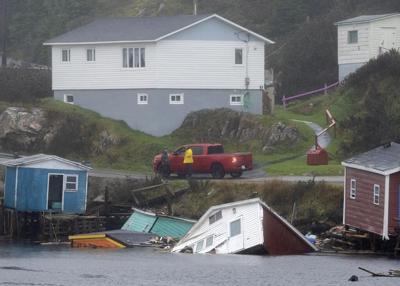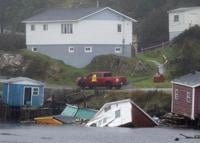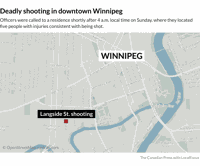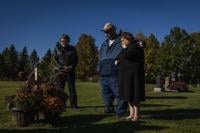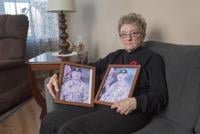ST. JOHN'S, N.L. - One year after a wave driven by post-tropical storm Fiona slammed into the back of her house and twisted it like a corkscrew, Lori Dicks now lives up on a hill, far from the water.
She still has a view of the ocean, but she's far enough away that there's no chance it will swell up and swallow her entire life again like it did on the morning of Sept. 24, 2022, in Port aux Basques, N.L.
"I still think about it all the time. So much change has happened for us, for everyone. Even the whole town I find is affected, even the landscape has changed," she said in a recent interview from her new home across the province in Burin Bay Arm, N.L. "On our side of the street where all our homes were, it's completely gone. All of our homes are torn down now."
Fiona destroyed about 100 homes that morning in southwestern Newfoundland, and a 73-year-old woman died when she was swept out to sea. Houses that had belonged to families for generations were washed away or destroyed, and some lost everything inside their home.
Dicks and her husband Claude had lived in their Port aux Basques home for nearly three decades. They raised their daughter there. After Fiona cracked its foundation, the house was deemed too dangerous to return to, and it was condemned. Dicks was allowed back in for a brief time to remove what she could.
She feels lucky she was able to salvage anything at all.
Port aux Basques has now established what it calls the high-impact zone ŌĆö an area deemed to be most at risk for severe damage from storms, even those with a fraction of Fiona's power. Some residents call it the "Fiona line."
Within that line, more than 80 homes were washed away by Fiona or later torn down after damage wrought by the storm left them uninhabitable, Mayor Brian Button said in an interview. Another 57 houses behind the line are still standing and occupied. Button said the owners will be bought out by the province so they can move somewhere else.
The provincial government has paid out about $41.6 million in compensation to people in southwestern Newfoundland who lost their homes in the storm, according to a statement from the Department of Justice and Public Safety. Owners of the 57 homes sill inside the impact zone will receive at least $200 per square foot for their houses, as well as money for their land, the department said.
The decisions to move people have been devastating to make, Button said, but they were necessary: Fiona crumbled so much of the town's shoreline into the sea, those houses are now dangerously close to the water.
"The whole thing is very emotional," he said. "We see all the damage that's around, that's visible. But nobody has realized the mental health aspect that this has had on the community."
"For me, personally, it's been a struggle ... just to mentally try to keep it together and deal with it all," he added.
Beyond the long hours and gut-wrenching decisions required of him as the volunteer mayor of a town beset by a crushing disaster, he's borne the brunt of some residents' grief. Heartbroken residents have yelled at him, only to approach him later in tears to apologize, he said.
"I've had people say to me, 'Well, you don't understand you didn't lose anything.'" But Button said he has sat with hundreds of affected families, and he's heard their stories and cried with them.
Ashley Smith is owner and managing director of St. John's-based climate consulting firm Fundamental Inc. She says that as the planet warms and powerful storms are expected to hit more frequently, the difficult discussions forced upon Port aux Basques need to happen in other coastal communities.
She uses the term "managed retreat" to describe a process of identifying vulnerable coastal areas, and perhaps enacting bylaws against building new homes in those areas and moving people out of them, just as Port aux Basques is doing.
"Any community along the coast is going to be vulnerable. Especially the small ones that are largely unchanged from like 50, 60, 70, 100 years ago," Smith said in a recent interview. "Most of the very small communities along (Newfoundland's) very long coasts are positioned right on the water ... and that is a vulnerable situation."
Nova Scotia's Atlantic coast is also vulnerable, she noted, as are parts of Prince Edward Island and New Brunswick.
Conversations about managed retreat are fraught, she acknowledges. Asking people to leave behind homes that in many cases were built by family members generations ago is not easy. Most towns also don't have the data they need to inform those decisions, she added.
But it will be safer and less traumatic for communities to begin the work voluntarily, rather than have it be forced upon them by a storm like Fiona, she said.
In their hilltop home in Burin Bay Arm, Dicks and her husband have started over. She's rebuilt her hairstyling business in her new community, and she's a short drive away from her 29-year-old daughter, who is set to give birth next month ŌĆö Dicks's first grandchild.
But she still fights back tears when she speaks about the morning Fiona hit, and the way it changed her life forever. She worries about her husband, who watched helplessly as the wave crashed into their house. Even their dog, Cooper, is having a hard time, she said.
She misses her neighbours back in Port aux Basques but doesn't think she could handle regularly passing by her old neighbourhood, where many of the homes are gone.
"In a way, I'm glad I'm not there to drive around on our street and see it," she said. "Because I don't think I could get past it, to tell you the truth."
This report by ┤║╔½ų▒▓źwas first published Sept. 24, 2023.

